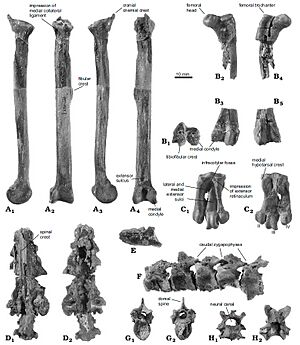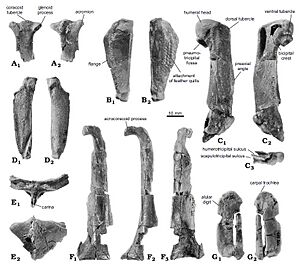Spheniscus muizoni facts for kids
Quick facts for kids Spheniscus muizoni |
|
|---|---|
 |
|
| Artistic reconstruction of Spheniscus muizoni | |
| Scientific classification | |
| Genus: |
Spheniscus
|
| Species: |
muizoni
|
The Spheniscus muizoni was an ancient type of banded penguin. It is now extinct, meaning it no longer lives on Earth. This penguin lived about 11 to 13 million years ago. That was during a time called the Miocene epoch.
Its home was in what we now call Peru, in South America. Scientists learned about this penguin from its fossils. These fossils were found in a special rock layer called the Pisco Formation. A scientist named Ursula B. Göhlich officially described the species in 2007. This ancient penguin is the oldest known member of the Spheniscus group. This group includes penguins alive today, like the Magellanic penguin.
Contents
Discovering the Muizon Penguin
Scientists found the fossils of Spheniscus muizoni in Peru. A French paleontologist named Christian de Muizon discovered them. A paleontologist is a scientist who studies fossils to learn about ancient life. He found the fossils in rocks from the Pisco Formation. This area is called Cerro la Bruja.
The fossils are now kept at the Muséum National d'Histoire Naturelle in Paris, France. The penguin was named muizoni to honor Christian de Muizon. He helped a lot by finding and studying many fossils from Peru.
What Spheniscus muizoni Looked Like
Scientists found many bones from this ancient penguin. The main set of bones, called the holotype, included parts of its body, wings, and legs. They found bones like its shoulder blades, arm bones (humerus and ulna), and leg bones (femur and tibiotarsus). They also found parts of its spine and tail.
Other bones, called paratype fossils, were also found. These were separate bones like more arm and leg bones. They also found a part of its tailbone and a rib.
Scientists estimate that Spheniscus muizoni weighed about 3.5 to 3.8 kilograms (7.7 to 8.4 pounds). This makes it smaller than some modern penguins. For example, the Magellanic penguin weighs about 4.5 kilograms (9.9 pounds). The Humboldt penguin is even bigger. But Spheniscus muizoni was larger than the Galapagos penguin, which weighs about 2.5 kilograms (5.5 pounds).
Scientists compared Spheniscus muizoni to other ancient and modern penguins. Its bones looked very similar to another ancient penguin called Spheniscus urbinai. S. urbinai lived in the same area but was much bigger. Scientists think that Spheniscus muizoni might have been an ancestor to S. urbinai. This means S. muizoni could have evolved into S. urbinai over time.
Spheniscus muizoni fossils have only been found at the Cerro la Bruja site. It is the oldest Spheniscus penguin ever found.
Its Ancient Home and Neighbors
The Pisco Formation is a special place for fossils. It holds rocks that are very old, from about 15 million years ago to 2 million years ago. The area where Spheniscus muizoni was found had sandy rocks and silty rocks. This shows that the area was once a shallow ocean.
Over millions of years, different types of Spheniscus penguins lived in this area. Spheniscus muizoni lived in the oldest parts of the Pisco Formation. Later, it was likely replaced by S. urbinai. Today, the Humboldt penguin (Spheniscus humboldti) lives in Peru.
Many other amazing ancient animals lived alongside Spheniscus muizoni. The Pisco Formation has fossils of:
- Giant sharks, including the famous megalodon
- Different kinds of whales and dolphins
- Seals
- Swimming sloths called Thalassocnus
- Other ancient birds, like Pelagornis
- Various fish and rays
Modern Spheniscus penguins mostly eat small fish like anchovies. They also eat squid and crabs. Scientists don't know exactly what Spheniscus muizoni ate. This is because its skull, which would show the shape of its beak, has not been found.
See also
 In Spanish: Pingüino de Muizon para niños
In Spanish: Pingüino de Muizon para niños



